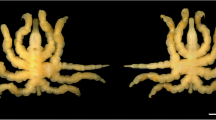Abstract
Several strains ofDrosophila hydei exhibiting an abnormal-abdomen (aa) phenotype were investigated. They proved to be mutant at one and the same major gene, located on chromosome 2 (homologous to 3R ofD. melanogaster).
This mutant gene,aa, causes skeletal abnormalities of the adult abdomen. Sternites and, less frequently, tergites are imperfectly sclerotized. They may be dissolved into separate areas, or may be missing altogether. Often they are normal in shape, while the number of hairs is reduced. Compound sclerites originating from parts of adjoining segments were never observed. Small hypoderm spherules with internal hairs occur frequently under the ventral skin. In aa larvae, segmentation is normal, in contrast to the situation in abnormal-abdomen mutants ofD. melanogaster. Even where theaa mutant expression is extremely strong, puparia are perfectly normal. Theaa gene thus appears to act exclusively during metamorphosis. This was confirmed by temperature experiments. The expression of theaa gene is much reduced at low temperature, but low temperature is effective during metamorphosis only.
The seven aa strains compared, showed considerable differences in penetrance and expressivity as well as in the amount of dominance in crosses. Reciprocal crosses yield in the F1 values either intermediate, or lower or higher, compared to those of the parent strains. The F1 values show a nonlinear correlation between penetrance and expressivity.
On the basis of chromosomal location and phenotypic effect, it is unlikely thataa ofD. hydei is homologous to any of the abnormal-abdomen mutants ofD. melanogaster described so far. However, a new dominant autosomal mutant was found inD. simulans, which seems to be a homologue.
Similar content being viewed by others
Literatur
Arendsen Hein S. A. (1920). Studies on variation in the meal worm,Tenebrio molitor.J. Genet. 10: 227–264.
Berendes H. D. (1962). The salivary gland chromosomes ofDrosophila hydei Sturtevant.Chromosoma (Berl.)14: 195–206.
Bertschmann M. (1955). Versuche zur phänokopierenden Wirkung von Chemikalien (Nitrogen-Mustard u.a.) beiDrosophila melanogaster.Z. Vererbungslehre 87: 229–266.
Bezem J. J. & F. H. Sobels (1953). Penetrance and expressivity in the genotypeAbnormal Abdomen ofDrosophila melanogaster.Proc. Kon. Ned. Akad. Wet., Series C,56: 48–61.
Buchmann W. & N. W. Timoféeff-Ressovsky (1938). Über die Wirkung der Temperatur auf den Mutationsprozess beiDrosophila melanogaster. V. Nicht-erbliche Modifikationen, ausgelöst durch Temperaturschocks in verschiedenen Entwicklungsstadien.Z. Vererbungslehre 74: 472–478.
Clayton G. A. & A. Robertson (1957). An experimental check on quantitative genetical theory. II. The long-term effects of selection.J. Genet. 55: 152–170.
Demerec M. (1950). Biology ofDrosophila. John Wiley & Sons, New York.
Epstein F. F. (1939). Über Modifikationen (Phaenokopien) der Flügelform nach Bestrahlung mit U.V.-Licht beiDrosophila.Genetica 21: 225–242.
Falconer D. S. (1964). Introduction to quantitative genetics. Oliver & Boyd, Edinburgh & London.
Franco, M. G. & P. G. Rubini (1963). Genetics ofMusca domestica L., Mutants, inheritance and cytology.Symp. genet. et biol. Ital. 13.
Friessen H. (1936). Röntgenmorphosen beiDrosophila.Arch. Entw. Mech. Org. 134: 147–165.
Fritz-Niggli H. (1951). Röntgenmodifikationen nach Bestrahlung mit 31-MeV-Betatronstrahlen und 180-keV-Röntgenstrahlen.Strahlentherapie 85: 233.
Geigy R. (1931). Erzeugung rein imaginaler Defekte durch ultra-veilette Eibestrahlung beiDrosophila melanogaster.Arch. Entw. Mech. Org. 125: 406–447.
Gloor H. (1947). Phänokopie-Versuche mit Acther anDrosophila.Rev. Suisse Zool. 54: 637–712.
Henke K., E. von Finck & S. Y. Ma (1941). Über sensible Perioden für die Auslösung von Hitzemodifikationen beiDrosophila und die Beziehungen zwischen Modifikationen und Mutationen.Z. Vererbungslehre 79: 267–316.
Lindsley, D. L. & E. H. Grell (1968). Genetic Variation ofDrosophila melanogaster. Carnegie Institution of Washington Publication 627. Washington, D.C.
Löbbecke E. A. (1958). Über die Entwicklung der imaginalen Epidermis des Abdomens vonDrosophila, ihre Segmentierung und die Determination der Tergite.Biol. Zbl. 77: 209–237.
Maas A. H. (1948). Über die Auslösbarkeit von Temperaturmodifikationen während der Embryonalentwicklung vonDrosophila melanogaster Meigen.Arch. Entw. Mech. Org. 143: 515–572.
Ritossa F. M. (1968). Unstable redundancy of genes for ribosomal RNA.Proc. Natl. Acad. Sci. (Wash.)60: 509–516.
Ross M. H. & D. G. Cochran (1961). A tergal abnormality in the German coekroach,Blattella germanica (L.).Ann. Ent. Soc. Amer. 54: 749–750.
Schäffer K. (1935). Untersuchungen beiDrosophila melanogaster über das rezessive Gena III (abnormal abdomen) und über einen neu aufgetretenen Austauschverhinderer C III L F.Z. Vererbungslehre 68: 336–360.
Sobels F. H. (1952). Genetics and morphology of the genotype “Asymmetric” with special reference to its “Abnormal Abdomen” character.Genetica 26: 117–279.
Spencer W. P. (1939). On the genetic structure ofDrosophila hydei populations.Genetics 24: 86–87.
Timoféeff-Ressovsky N. W. (1931). Gerichtetes Variieren in der phänotypischen Manifestierung einiger Genovariationen vonDrosophila funebris.Naturwissenschaften 19: 493–497.
Timoféeff-Ressovsky N. W. (1932). Die heterogene Variationsgruppe “abnormes Abdomen” beiDrosophila funebris.Z. Vererbungslehre 62: 34–46.
Thélin L. (1954). Etude génétique de deux anomalies abdominales deDrosophila repleta.Rev. Suisse de Zool. 61: 453–461.
Ulrich H. (1951). Sensitive periods and egg-regions in production of the modification “abnormal abdomen” by X-raying eggs ofDrosophila melanogaster.DIS 25: 131.
Villee C. A. (1947). A quantitative study of phenocopy production with monochromatic ultraviolet irradiation.Biol. Bull. 92: 1–9.
Zimmermann W. (1954). Über genetisch und modifikatorisch bedingte Störungen der Segmentierung beiDrosophila melanogaster.Z. Vererbungslehre 86: 327–372.
Author information
Authors and Affiliations
Rights and permissions
About this article
Cite this article
Kobel, H.R., van den Bosch, J.J. Abnormal-abdomen beiDrosophila hydei . Genetica 41, 119–140 (1970). https://doi.org/10.1007/BF00958899
Received:
Issue Date:
DOI: https://doi.org/10.1007/BF00958899




